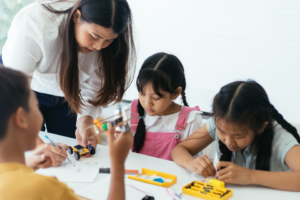Addressing Student Anxiety Through Exercise

School evokes a variety of responses from students. It can produce anxiety like few other experiences a young person can have. Even for college students, anxiety can still play a big role in their day to life so if you are at college you should see how full specturm cdb tinctures could help you. In students who might be predisposed to feeling anxiety, school can exacerbate existing tensions in ways that interfere with learning as well as overall health. Effectively combating this might require drastic paradigm shifts in schools that aren’t likely to happen. Even if schools go to great lengths to accommodate students who wrestle with anxiety, the anxiety might need to be addressed internally rather than externally. The good news is students might be able to address their anxiety on their own terms. One of the best remedies seems to be exercise. Other options include Hypnosis. It might be worth checking out an Orlando Hypnosis review first.
Some studies point to students experiencing anxiety at unprecedented rates. Perhaps increasing diagnoses reflect improved instruments used for diagnosis, or more encompassing criteria than had been used in previous decades. The increased incidence might reflect a greater societal sensitivity to anxiety resulting in more attention to it. Of course, some of the increase might be due to various forms of over-reporting. However, even if many of the cases stem from this, the remainder seems to represent a growing body of students who struggle with anxiety.
The causes of anxiety could be a topic for another article—even an entire book. Many causes would be similar to those affecting adults. Indeed, the internal causes of anxiety tend to be present throughout one’s life. Some external causes are specific to student life, though. Students must contend with social pressures from peers, body image issues, and the general stresses of keeping up with coursework. Pressures related to college admission are a source of anxiety for some. Opponents of standardized testing would cite the increased emphasis on testing as another student-specific source. Additionally, we can only speculate about how increasing reliance on technology might be affecting all of us. This might disproportionately affect young people.
These external causes can be minimized but not eliminated. If they produce anxiety, the most practical approach is to deal with the anxiety systematically. Therapy and medication are typical anxiety remedies, but alternatives exist. Connections between exercise and stress reduction are well established. Exercise produces benefits beyond stress relief, making it desirable in and of itself. Importantly, students can manage exercise on their own. The trick for students (and the adults in their lives) is finding the right venue for it.
Despite the proliferation of scholastic sports and the high level of student engagement in extracurricular activities, the American student population as a whole remains inactive. A substantial number of young people do not exercise at all. Anxiety and depression rates among students might very well be related to this lack of activity. Body image issues associated with inactivity likely contribute to additional anxiety. Weight gain combined with a sedentary lifestyle might contribute to depression. Inactivity due to a mixture of anxiety and depression begets further inactivity, leading to a detrimental spiral.
Convincing students who struggle with anxiety to exercise is the complicated part. Unfortunately, organized sports aren’t necessarily the answer. Inactive students might not make scholastic teams. Furthermore, being on scholastic sports teams can create additional anxiety. Some students will thrive amid group dynamics, but others will shrink from such situations. Particular students might resist any organized group activity, at least initially. Parents and educators can face a profound barrier in reaching the students who might benefit most from exercise.
For students who might do best with solo and non-sanctioned activities, options abound. Yoga combined with meditation can be a great start. Students can use the stretching and breathing exercises of yoga to increase flexibility and mitigate stress. They don’t necessarily need an instructor or a dedicated space. Yoga offers techniques that students in almost any physical condition can use. Best of all, the physical and mental benefits of starting with yoga and meditation can lead to other activities.
Students can run anywhere. Running requires little equipment and almost no coaching or training. Some prerequisites include a safe enough neighborhood in which to run. Even blighted neighborhoods often offer a school track that might be available for safe running. An echelon of physical ability is necessary as well. Some students might need to start by walking. Advancing from walking to running takes surprisingly little time. Those students who use manual wheelchairs can benefit just as much from vigorous movement, with the upper-body workout possibly being more vigorous than running on legs.
Adults can facilitate running or walking before or after school as non-team activities for groups or individual students. In places where this would be practical, sponsoring walk-to-school days could be a way to get sufficiently large groups of students walking in a way that could make the experience safe for all involved. Schools can encourage students to ride bicycles to school as well. Facilitating this requires safe spaces to lock the bicycles, which would be a minimal investment considering the potential health benefits.
Many students will continue to balk at any of these ideas, especially if adults suggest them. Teenagers might seek their own physical outlets, preferring solo activities like skateboarding. Parents and teachers really shouldn’t discourage this. Kids can skate safely and get a workout. If anything, parents might at the most insist that their kids wear helmets, especially when skating in dedicated parks. Other young people might take to something as novel as parkour or freerunning. It might seem dangerous, but so are football and cheerleading in terms of injuries per year. If a young person wants to use parkour as a way to keep fit and vicariously to manage anxiety, adults should be as accommodating as possible.
Exercise alone isn’t likely to eliminate anxiety, but it could help young people manage it. Some students will need to find their own path to physical activity for them to stick with a routine. The adults in their lives should be as supportive as possible, recognizing the benefits of students finding the exercise that works for them. These activities need not be overly structured. Hiking with a family dog could have worlds more benefit than trying out for a softball team. With anxiety being as prevalent as it appears to be among students, parents and educators need to be open to whatever options allow students to find a physical release.
Written by Jeff Hartman



